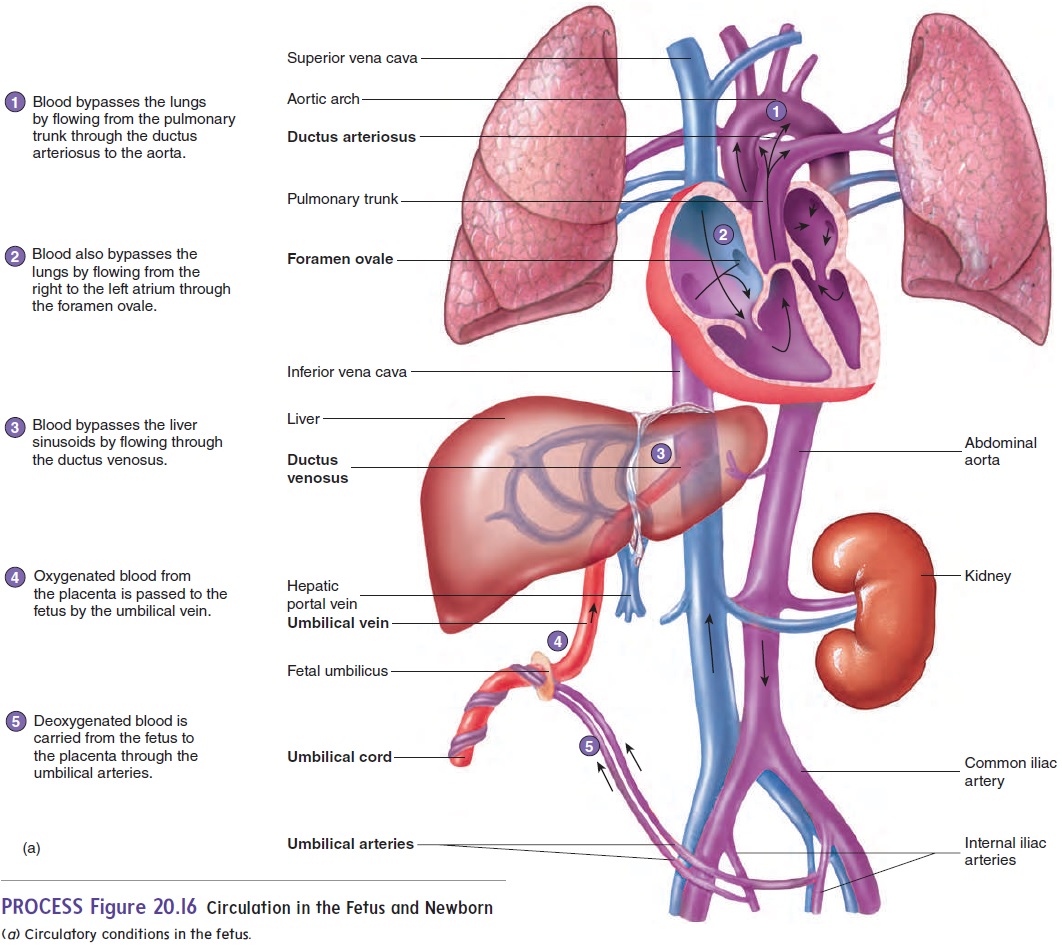Chapter: Essentials of Anatomy and Physiology: Development, Heredity, and aging
The Newborn
THE NEWBORN
The newborn, or neonate (nē′ ō-nāt; newborn), experiences several dramatic changes at the time of birth. The major and earliest changes are the separation of the infant from the maternal circula-tion and the transfer from a fluid to a gaseous environment.
Respiratory and Circulatory Changes
The large, forced gasps of air that occur when an infant cries at the time of delivery help inflate the lungs. The fetal lungs produce a substance called surfactant (ser-fak′ tănt), which coats the inner surface of the alveoli, reduces surface tension in the lungs, and allows the newborn lungs to inflate .
Surfactant is not manufactured in the fetal lungs before about 6 months after fertilization. If a fetus is born before the lungs can produce surfactant, the surface tension inside the lungs is too great for the lungs to inflate. Under these conditions, the newborn may die of respiratory distress. Therefore, premature newborns are treated with bovine or synthetic surfactant.
The initial inflation of the lungs causes important changes in the cardiovascular system (figure 20.16). Expansion of the lungs reduces the resistance to blood flow through the lungs, resulting in increased blood flow from the right ventricle of the heart through the pulmonary arteries. Consequently, an increased amount of blood flows from the right atrium to the right ventricle and into the pul-monary arteries, and less blood flows from the right atrium through the foramen ovale to the left atrium. The reduced resistance to blood flow through the lungs and the increasing volume of blood returning from the lungs through the pulmonary veins to the left atrium make the pressure in the left atrium greater than that in the right atrium. This pressure difference forces blood against the interatrial septum, closing a flap of tissue that develops in that region over the foramen

This action completes the separation of the heart into two pumps: the right side and the left side of the heart.
A short artery, the ductus arteriosus (ar-tēr′ ē-ō-sŭs), connects the pulmonary trunk to the aorta. Before birth, the ductus arteriosus carries blood from the pulmonary trunk to the aorta, bypassing the fetal lungs. This artery closes off shortly after birth, forcing blood to flow through the lungs.
Also before birth, the deoxygenated fetal blood passes to the placenta through umbilical (ŭm-bil′ i-kăl) arteries, which originate in the internal iliac arteries. As the blood passes through the pla-centa, nutrient and waste exchange occurs between the fetal blood and the maternal blood. Oxygenated fetal blood then returns to the fetus through an umbilical vein. The umbilical vein passes through the liver but bypasses the sinusoids of the liver by way of the ductus venosus (vē-nō′sŭs) and joins the inferior vena cava. Whenthe umbilical cord is tied and cut, no more blood flows through the umbilical vein and arteries, and they degenerate. The remnant of the umbilical vein becomes the round ligament of the liver.
Digestive Changes
Late in gestation, the fetus swallows amniotic fluid from time to time. Shortly after birth, this swallowed fluid plus cells sloughed from the mucosal lining of the digestive tract, mucus produced by intestinal mucous glands, and bile from the liver are eliminated as a greenish anal discharge called meconium (mē-kō′ nē-ŭm).
After birth, the neonate is suddenly separated from its source of nutrients, the maternal circulation. Because of this separationand the shock of birth, the neonate usually loses 5–10% of its total body weight during the first few days of life. Although the digestive system of the fetus becomes somewhat functional late in development, it is still very immature in comparison to that of the adult and can digest only a limited number of food types. The newborn digestive system is capable of digesting lactose (milk sugar) from the time of birth. The pancreatic secretions are suffi-ciently mature for a milk diet, but the digestive system only gradu-ally develops the ability to digest more solid foods over the first year or two. New foods should therefore be introduced gradually during the first 2 years. Parents are also advised to introduce only one new food at a time, so that, if an allergic reaction occurs, the cause is more easily determined.
Amylase secretion by the salivary glands and the pancreas remains low until after the first year. Lactase activity in the small intestine is high at birth but declines during infancy, although the levels still exceed those in adults. In many adults, lactase activity is lost, and an intolerance to milk develops.
Related Topics